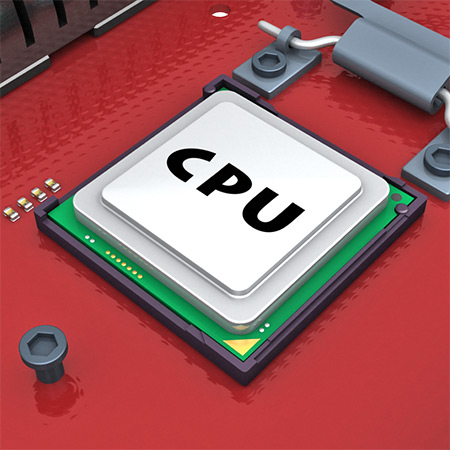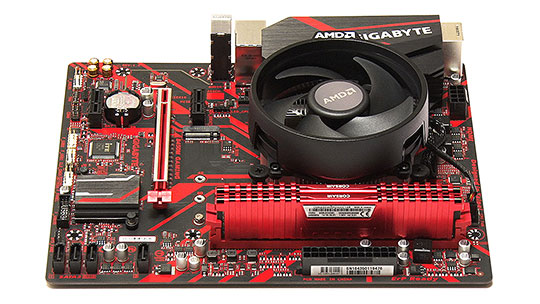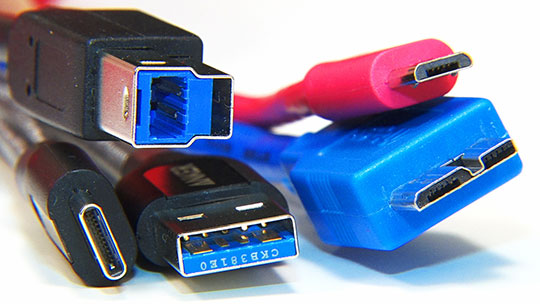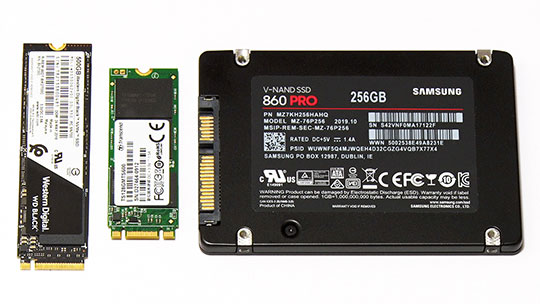 |
|
|
|
Hardware
Hardware refers to all of the physical parts of a computer system, including its processor, memory, storage, communications interfaces, display and power supply. The following video provides an eight-minute summary of all of the different hardware components found in a desktop PC. And below the video, things are expanded on further. If you are looking for information about a particular kind of hardware, there is a lot of information in the ExplainingComputers hardware guides. And if you want to see how components are selected and a desktop PC is put together, just checkout my PC Build & Upgrade Videos. PROCESSOR SPECIFICATIONSAt the heart of any computer is its processor, also known as its "microprocessor" or its "central processing unit" or CPU. This is the component that actually performs digital computation, as I discuss my video How do CPUs Work?. Key processor specifications include its ISA, clock speed, core count, multithreading and cache. So let's look at each of these in turn. ISA stands for "instruction set architecture", and today practically all computers are based on either an x86 or ARM ISA. The x86 ISA was created by Intel, and was initially 16-bit, which means that it processed data and communicated with other components (such as memory) using 16 binary address lines. To allow the x86 ISA to become more powerful, it was later extended by Intel to 32-bit, and then again by AMD into its current 64-bit incarnation. The 64-bit version of the x86 ISA is technically known as AMD64, x86-64, x86_64 or x64. Some people still use the term "x86" to only refer to 32-bit chips (somehow forgetting that there were earlier 16-bit x86 processors). However, increasingly, the term "x86" is used as a family name that denotes any processor with an x86 (16 or 32-bit) or x86-64 (64-bit) architecture. And given that 32-bit x86 chips are no longer made, it is normally very clear what is implied. Today, both Intel and AMD sell 64-bit x86 processors, with the two companies having licensing agreements that allow this to occur. I have a pretty recent video that explains the current range of Intel & AMD CPUs. Today's other dominant ISA is ARM. ARM designs are created by ARM Limited, and then licensed to companies who make ARM processors. Practically all Android and iOS devices have an ARM processor. So too do most of the PCs in Apple's current desktop and laptop lineup, which are based on a range of processors called M1 and M2. Apple's fairly recent transition from x86 to ARM is discussed in this video. Whilst x86 and ARM current dominate end-user and server computing, the RISC-V ISA is also rapidly developing into a future contender, as discussed on the RISC-V page and in my RISC-V videos. It is now a very safe bet that by 2030, end-user and server computers will be based on one of three ISAs -- x86, ARM or RISC-V. Moving on from ISA, a processor's clock speed is measured in gigahertz, and the higher the value, the more instructions a processor can execute per second. Today, most processors have both a base clock frequency, as well as a turbo or boost frequency which they can operate at if they remain within safe temperature and power limits. Today, most maximum processor speeds tend to be between about 1.5GHz and 5GHz. Core count indicates how many individual processing units a processor contains, and hence how many tasks -- or "threads" -- it can execute at the same time. Parallel processing is further enhanced if a processor supports multithreading, which uses virtualization to allow each single core to run more than one thread at the same time. Intel’s multi-threading technology is called hyper-threading, whilst AMD’s is known as simultaneous multi threading or SMT. Usually multithreading doubles the thread count so that, for example, a quad core processor can execute eight threads simultaneously. However, processors with four-way multithreading have been produced to allow each core to run four threads at the same time. It used to be that all of the cores in a processor were identical. However, today this is often not the case. This trend was started by ARM, with "big.LITTLE" designs that included a mix of less powerful and more powerful cores. A key benefit is that only the lower power (and hence lower energy) cores have to be used when there is little to process, so extending the battery life of tablets and smartphones. The latest Intel processors now also feature a mix of "E" and "P" (efficient and performance) cores. This whole matter is discussed in more depth in my video The big.LITTLE CPU Revolution. Finally we get to cache, which is a type of very fast RAM (memory) built into a processor, and which improves its performance by reducing the requirement to transfer data into and out of standard RAM. So, the more cache a processor has, the better it will perform. Cache also comes in three categories -- known as level 1, level 2, and level 3, with level 1 being the fastest but also the most expensive.
MOTHERBOARDS & INTERFACESInside every computer is a motherboard. In a desktop PC, this will have a socket for the processor, as well as slots for inserting memory modules (in case you are wondering, in some laptops and most tablets and smartphones, the processor and memory are directly soldered in place). There is more information on memory (DIMM) slots in the next section. Also included on a desktop PC motherboard are "peripheral component interconnect express" or "PCIe" slots for adding graphics and other expansion cards. And there will also be SATA and possibly SAS or U/2 ports for connecting drives. On a new motherboard today, there will typically also be one or more M.2 slots for connecting SSDs or other devices, and often a wireless module to provide Wi-Fi and Bluetooth connectivity. And there will be "front panel connectors", to hook up the computers front switches and indicator LEDs. Along one edge of a desktop PC motherboard there will additionally be USB or "universal serial bus" ports of various kinds, as well as one or more Ethernet ports for connecting to a wired network. In addition, there will be one or more display connectors, audio jacks, and possibly other connectors such as a Thunderbolt port or a PS/2 mouse or keyboard socket. If you would like to know learn more about any of these interfaces, they are discussed in general in the video embedded at the top of this page, and in far more depth in the following individual videos:
CHIPSETSTo allow a computer's processor to work with other components, a motherboard requires a chipset. This functions as a kind of digital glue, and must be compatible with a computer's processor. Or as Intel explain, “the chipset is a silicon backbone integrated into the motherboard that works with specific CPU generations. It relays communications between the CPU and the many connected storage and expansion devices”. On a modern motherboard, the chipset is a single integrated circuit, which may also be referred to as the "platform controller hub" or PCH. As the chipset determines which processors a motherboard supports, the name of the chipset is usually included in a motherboard’s product name. So, for example, a GIGABYTE B650 GAMING X AX motherboard contains an AMD B650 chipset. Whilst the chipset on a modern motherboard is a single integrated circuit, until fairly recently it was split across two or more components. In particular, for many years the chipset was divided across two chips -- the "Northbridge" towards the top of the motherboard, and the "Southbridge" towards the bottom -- with these two components together forming the total "chip set". In such designs, the Northbridge -- also known as the memory controller hub -- connected the processor to high speed components, such as the memory, display and PCIe slots. Meanwhile the Southbridge -- also known as the I/O hub -- linked the processor to slower PCI slots, as well as to other lower speed interfaces, including SATA, USB and Ethernet ports, and onboard audio. But when Intel launched their first desktop Core processors in 2008, they took the memory controller and some other parts of the Northbridge, and integrated them into the processor package. Other Northbridge functions were moved to the Southbridge, so giving us the single chipset configuration that is still included on motherboards today. You can learn more about chipsets in my video Explaining Motherboard Chipsets. However, the most important thing to keep in mind is that any motherboard's chipset only supports certain processors (some of which may only work following a BIOS upgrade). So if you are selecting components for a PC build or upgrade, it is very important to play close attention to chipset/processor compatibility. RAMRAM -- or "random access memory" -- is the temporary storage into which a computer loads software applications and user data when it is running. All current RAM technologies are "volatile", which means that everything held in RAM is lost when a computer's power is removed. To a large extent, the more RAM a computer has, the faster and more effectively it will operate. Computers with little RAM have to keep moving data to and from their SSDs or hard drives in order to keep running. This tends to make them not just slow in general, but intermittently sluggish. RAM is measured in megabytes (MB) and gigabytes (GB), as detailed on the storage page. Today, 4GB is the minimum recommended RAM for a modern Windows or Linux PC, with 8GB becoming very common, and 16GB or more required for some professional video editing and other high-power applications, especially if you need to run several such programs at the same time. If you are wondering, ExplainingComputers videos are edited on a PC with 32GB of RAM, and whilst I could "live" in 16GB, it would deliver a less enjoyable and slower working experience. Over the years, RAM has evolved significantly, with early standards for RAM modules including the SIP (or “single in-line package”) and SIMM (or “single inline memory module”). But today, all desktop PC RAM comes in a form-factor known as a DIMM, or “dual in-line memory module”. Many mini PCs and laptops then use a variant called SO-DIMM -- or "small outline DIMM" -- that is physically smaller for obvious reasons. For optimum performance, identical sets of DIMMs need to be installed into matching slots or “banks” on a computer’s motherboard. This allows the RAM to run in a “multi-channel” mode that maximizes the speed at which it can be accessed. Motherboards that accommodate two DIMMs per channel are known as "dual-channel", and run most effectively with DIMMs installed in matching pairs. Meanwhile, the latest quad-channel motherboards perform to their optimum when fitted with quartets of DIMMs. The memory cells that store each bit of information in a RAM chip can be either static or dynamic. In static RAM -- or SRAM -- each memory cell consists of four or more transistors that maintain data as long as constant power is supplied. In contrast, in dynamic RAM -- or DRAM -- each memory cell is built from a single transistor and a capacitor that requires a periodic power refresh. Because SRAM does not have to be constantly refreshed, it is faster. However, SRAM is also more expensive to manufacture than DRAM because more components are required for each memory cell. As a consequence, SRAM is used to provide processors, SSDs and hard drives with some very fast, intermediate storage called cache. However, most desktop and laptop RAM uses DRAM technology to provide the highest capacity for the lowest cost. Specifically today, desktop PCs and other end-user devices are fitted with SDRAM modules. SDRAM is a development of DRAM which stands for synchronous dynamic RAM. What this means is that SDRAM operates in synchronisation with a computer’s CPU clock cycle, which reduces wait times for the processor and hence improves performance. Back in 2000, a development of SDRAM called DDR SDRAM was introduced. DDR stands for double data rate, and means that the RAM operates twice as quickly, as two data transfers take place per clock cycle, rather than just one. Since its introduction, DDR SDRAM has been improved several times, with subsequent generations called DDR2, DDR3, DDR4 and DDR5. Later generations of DDR SDRAM offer increasingly higher performance, and have slightly different physical form factors. RAM modules in each DDR generation are available in a range of speeds. RAM speed can be expressed in several different ways, with a data rate cited in megatransfers per second (MT/s), and an associated peak transfer rate listed in megabytes per second (MB/s). And in practice, many manufacturers just cite RAM speed in the latter measure -- for example "16GB DDR5 SDRAM DIM 5600 MHz". If you browse the specifications of mobile devices and SBCs, you are likely to discover that they have "LPDDR" RAM. And here, the "LP" bit stands for lower power. For an expanded version of the above explanation of RAM, with lots of visual and practical examples, see my video Explaining RAM. GPUsA computer's graphics processing unit, or "GPU", generates and outputs the video image that is displayed on its screen, and so determines how well it can work with visual output. Today, GPUs can either be expansion cards plugged into a PCIe slot on a computer's motherboard, or integrated into a computer's processor. Here it is worth noting that, not than many years ago, a computer with "integrated graphics" actually had the GPU integrated into the motherboard, rather than in the CPU package, and so was often described as having "onboard graphics". But in modern PCs this is no longer the case. Today, GPUs integrated into a CPU package (termed "APUs" or "accelerated processing units" by AMD) can be quite powerful, and are usually sufficient for handling the requirements of most applications aside from high-end gaming, 3D modelling, and professional video editing. And so if a computer is not going to be used for such purposes, a separate graphics card is not needed. All of Apple's latest ARM ISA computers rely on a GPU integrated into their M1 or M2 family processor, with the integration of a higher and higher power GPU onto the processor package being a clear direction of travel. Regardless of whether a computer has a separate graphics card or integrated graphics, it has to connect to a monitor via some means. Today available options include VGA, DVI, HDMI, DisplayPort, Thunderbolt and USB-C -- which are all explained and illustrated in my video Explaining Display Connectors. STORAGEBecause the contents of RAM are lost when power is removed, all computers require some "non-volatile" storage on which to store their operating systems, applications and data. Current options include internal solid state drives (or "SSDs"), eMMC (or "embedded multimedia card", which is an alterative form of flash storage used in tablets, smartphones and some laptops), and internal hard disk drives (HDDs). In addition, optical drives (such as DVD and BluRay units) are still around in some quarters. Many people also continue to store and transfer data on external SSDs or hard drives, as well as on flash drives that plug into a USB port. The latter are variously known as "USB drives", "USB keys", "memory keys", and many other things. And because ExplainingComputers has a dedicated storage page, I will say no more about storage technology here! INPUT DEVICESSo far, everything detailed on this page has lived inside the case of a desktop PC. But without human-computer input devices, they would be of little value. Today, keyboards remain the dominant means of getting most textual and numeric data into a computer. And they have also changed relatively little over the past couple of decades. Those developments that have taken place tend to have involved the inclusion of more and more special function keys, wireless technologies, and improvements to assist with display screen equipment health and safety regulations. Early IBM PC keyboards, for example, whilst being extremely robust, had such solid keyboard switches that many people who typed on them all day soon developed repetitive strain injury. In contrast, most modern keyboards (designed for typists rather than engineers who do not spend all day typing) require a far lighter touch. Alongside keyboards, mice, touchscreens and other pointing devices are the other dominant form of computer input. The first mouse was invented by Doug Engelbart in the early 1960s and made out of wood, with its history detailed here. The basic principle of moving around a small, buttoned device to in turn position and select with a pointer on a computer screen also remains unchanged to this day. What has changed is the variety of "rodents" now available. Many are now wireless (and hence I guess technically "hamsters"), whilst others have evolved into pads or trackballs built into laptop computers. And of course today many people point and click directly on a tablet or smartphone touchscreen. For accurate graphics work, graphics tablets are now also the choice of many, with a pen or other tool being used on a special surface, or directly on a screen. Microphones, webcams and other digital cameras have over the past ten years also significantly expanded the way in which a great many people input data into a computer. Voice input, video calling, digital photography and videography are now commonplace, and indeed the majority of new computing devices now have at least one integrated camera and microphone. In fact, integrated cameras are so ubiquitous that stand alone scanners are less commonly found, and when they do exist, tend to be integrated into printers Over the coming years, voice and visual computer input is set to expand rapidly. A few decades from now, we may also start to commonly use brain-computer interfaces (BCIs) to directly interface our own, natural computing wetware with an inorganic counterpart (and in turn all other natural and artificial computing devices). Right now, Elon Musk's company Neuralink is working to "create a generalized brain interface to restore autonomy to those with unmet medical needs today and unlock human potential tomorrow". And in September 2023 it began recruiting for human trials. You can learn more about BCIs -- and see my trying one out -- in my video Brain-Computer Interfaces. OUTPUT DEVICESFinally we get to those devices that present digital data back into the realm of human perception (and which in the future may also be BCIs). But today, LCD monitors, touchscreens, speakers, headphones and earbuds remain the dominant means of computer output, with printers increasingly being left behind as the long-predicted paperless world finally arrives. Most printers now use lasers to fuse toner on paper, or inkjets to spray, well, jets of ink. Printing is also no longer just a flat, 2D process, with 3D printing (aka additive manufacturing) by far the most interesting thing that has happened to digital output for a long time. It's also a subject that I have loads of content about over in the 3D Printing Section of ExplainingTheFuture.com. Oh, and before I finish here, I ought to mention the head mounted displays (HMDs) that allow us to enter virtual reality (VR) and increasingly augmented reality (AR). Whilst very useful for certain kinds of training and design work, still these have not taken off to the extent long-predicted. And this is almost certainly because (a) we have learned to enter cyberspace on screens, and (b) HMDs still make of lot of people feel ill. But who knows? In ten years time we may all be living the Facebook/Meta dream of daily forays into the Metaverse (a subject I discuss in depth here). However, my own prediction is that the interface device to take us into the next computing age will be the BCI and not the HMD, as decades hence we embrace a brave new world of Cyborg Fusion. CLOSING COMMENTSUnless you are a games player, 3D graphics artist or professional video editor, you will probably find that most modern personal computers will be adequate for your requirements. Your chosen input and output devices, as well as the software you wish and need to run, should therefore primarily drive your computing requirements. So do try to be wary of sales people trying to flog you hardware of a specification you will not use. Reflecting on the above, for many years the computing industry was dominated by hardware. Then it was software that became most significant in terms of value added. And today we have moved on to connectivity, content, and increasingly artificial intelligence. This important point made, we do still need to run software, and to connect, share content, and interact with AIs, on computer hardware of some kind. So I hope that this page, and the videos to which it links, have been of some use. |
 Hardware refers to all of the physical parts of a computer system. |
|
| ||


